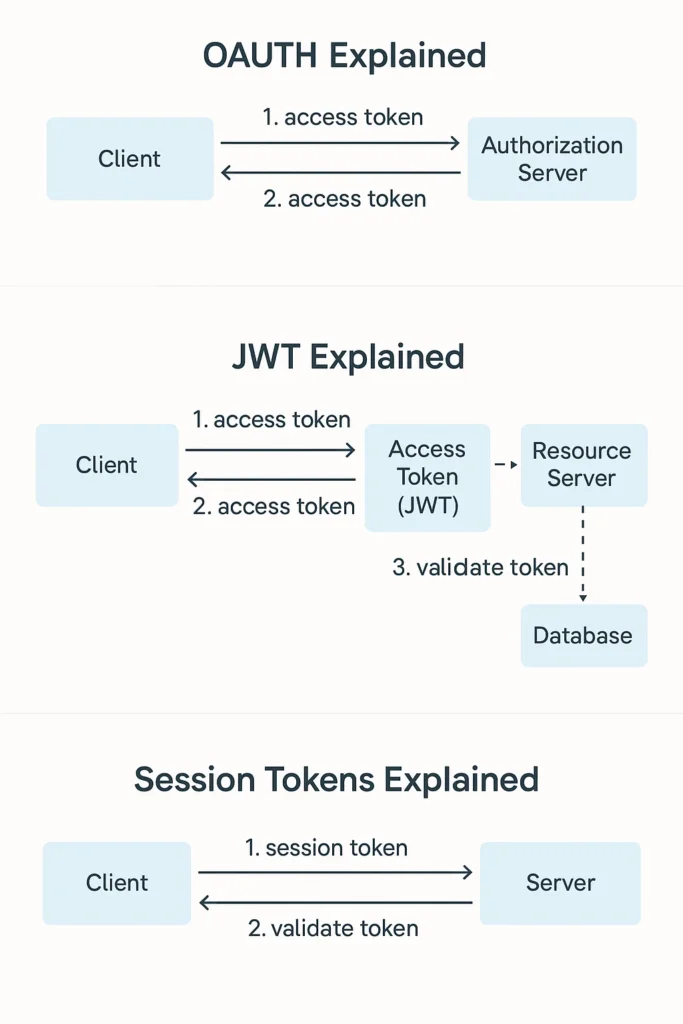
Authentication can be confusing — especially when buzzwords like OAuth2, JWT, and session tokens get thrown around interchangeably. This guide breaks it all down with clear diagrams and real-world analogies, so you’ll finally understand how modern authentication actually works.
🧩 What Are We Trying to Solve?
Before diving into tokens and protocols, let’s start with the basic question:
“How can a server know that a user is authenticated?”
Answer: By giving them a token — a temporary proof of identity. How that token is issued, validated, and stored depends on whether you’re using sessions, JWTs, or OAuth2.
🔐 1. What Are Session Tokens?
Session tokens are the classic way to manage user authentication.
🟢 How It Works:
- User logs in (e.g., with email/password)
- Server creates a session and stores it in its memory or database
- Server sends back a session ID
- The browser stores the session ID (usually in a cookie)
- On every request, the session ID is sent back to the server
- The server looks it up and confirms the user is logged in
🧠 Diagram:
[ Client ] <-- login --> [ Server ]
<-- session ID --
[ Client ] <-- sends session ID on each request -->
[ Server ] <-- looks up session ID --> user info
✅ Pros:
- Simple and secure (if cookies are configured properly)
- Server controls session expiration
❌ Cons:
- Doesn’t scale well with microservices or mobile APIs
- Requires shared session storage across servers
🧾 2. What Is JWT (JSON Web Token)?
JWT is a self-contained token that contains the user’s identity and claims — like a digitally signed note.
🟢 How It Works:
- User logs in
- Server creates a JWT (with user ID, email, etc.)
- JWT is sent to the client (stored in localStorage, cookie, etc.)
- Client sends the JWT on each request (usually in the
Authorizationheader) - Server verifies the signature, reads the token, and trusts the user
🧠 Diagram:
[ Client ] <-- login --> [ Server ]
<-- JWT Token --
[ Client ] <-- sends JWT on each request -->
[ Server ] <-- verifies JWT --> reads user info from token
✅ Pros:
- No need to store sessions on the server
- Ideal for stateless APIs
- Easy to use with mobile apps and microservices
❌ Cons:
- Can’t be revoked unless you maintain a blacklist
- If compromised, the token is valid until it expires
🌐 3. What Is OAuth2?
OAuth2 is not an authentication protocol — it’s an authorization framework.
It allows third-party apps (like yours) to access a user’s data without getting their password.
Example: “Log in with Google” or “Connect to GitHub”
🟢 How It Works:
- User clicks “Log in with Google”
- App redirects to Google’s OAuth2 server
- User grants access
- Google redirects back with an authorization code
- App exchanges the code for an access token
- App uses the token to fetch user data
🧠 Diagram:
[ Client ] --> [ Google OAuth ]
<-- grant access
[ Client ] <-- authorization code --
[ Server ] --> [ Google Token API ] --> access token
[ Server ] --> [ Google API ] --> user info
✅ Pros:
- Secure and standardized
- Used by Facebook, Google, GitHub, etc.
- Tokens can have scopes (e.g., read-only)
❌ Cons:
- Complex setup
- Often confused with login — need OpenID Connect for identity
🔄 Session vs JWT vs OAuth2 (Quick Comparison)
| Feature | Session Tokens | JWT | OAuth2 |
|---|---|---|---|
| Stored On Server | ✅ Yes | ❌ No | ❌ No |
| Scalable for APIs | ❌ No | ✅ Yes | ✅ Yes |
| Token Revocation | ✅ Easy | ❌ Difficult | ✅ Built-in |
| Used For Login? | ✅ Yes | ✅ Yes | ⚠️ Not always* |
| Example Use | Traditional web apps | Mobile / SPAs | “Log in with…” |
*OAuth2 handles authorization; for authentication, it should be paired with OpenID Connect (OIDC).
🧠 Real-World Analogy
- Session Token: You’re on a guest list at a party — the bouncer checks it every time.
- JWT: You carry a signed badge with your name and role — anyone can verify it.
- OAuth2: You give permission to a friend (the app) to access your house using a key from your landlord (Google).
✅ When Should You Use Each?
| Use Case | Best Option |
|---|---|
| Web app with server | Sessions |
| Mobile app or SPA | JWT |
| Third-party account login | OAuth2 + OIDC |
| Microservices backend | JWT or OAuth2 |
🏁 Final Thoughts
Modern authentication can feel like a maze, but it all comes down to trust — and how you prove it.
- Use sessions for simplicity and control
- Use JWTs for scalable, stateless APIs
- Use OAuth2 when delegating access or logging in via third-party services
👉 Want a deep dive into implementing these in Flutter, Node.js, or Spring Boot? Stay tuned — we’ve got tutorials coming.